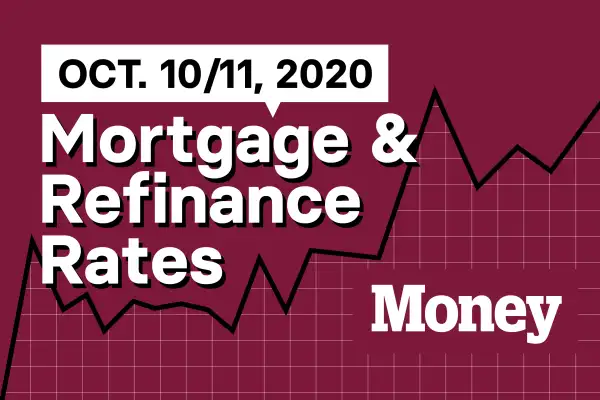Today's Mortgage and Refinance Rates for October 10 and 11

The average rate for a 30-year fixed-rate purchase mortgage was 3.487% on Thursday. The average rate for a 30-year refinance was 4.342%.
Money's most recent mortgage rates include data from 8,000 lenders across the United States and are updated daily. The rates include points and represent what a borrower with a 20% down payment and 700 credit scores — roughly the national average FICO score — would have been quoted.
| 30-year fixed-rate purchase mortgage |
| 3.487% |
| Rate of October 8, 2020 |
Mortgage rates vary from state to state. On Thursday, borrowers in Alaska were quoted the lowest mortgage rates — at 3.327%. People looking for mortgages in Nevada saw the highest average rate at 3.695%. Nationwide, borrowers with the highest credit scores, 740 and above, were quoted rates averaging 3.022%, while those with credit of 640 or below were shown rates of 4.725% — a 1.703 percentage-point spread.
You may be able to negotiate a lower rate if you shop around or if you have other accounts with the lender. (Money's picks for the best mortgage lenders are here.) Currently, some banks are hiking up advertised rates to keep demand in check, so you may be offered a lower rate if you reach out directly.
Freddie Mac's widely quoted Primary Mortgage Market Survey put rates at 2.87% with 0.8 points paid for the week ending October 8. The mortgage purchaser's weekly survey reflects borrowers who put 20% down on conforming loans and have excellent credit.
Refinance rates today
Money's most recent survey also shows that the offered rate for a 30-year refinance for someone with a 740 credit score was 3.683% on Thursday. Last October, the average mortgage rate (including fees) was 3.859%.
| 30-year fixed-rate mortgage refi |
| 3.683% |
| Rate of October 8, 2020 |
A homeowner with a $200,000 mortgage balance currently paying 3.859% on a 30-year loan could potentially cut their monthly payment from $939 to $919 by financing at the current lower rates. To determine if it's worth it to refinance your mortgage, also consider the closing fees you paid on your current mortgage, how much your new lender is charging and how long you have left on your loan term. (Our picks for the best lenders for refinancing are here).
The Week in Review
The housing markets continued to show resiliency at the start of October, as demand and transactions remain strong at a time when activity usually slows down.
In August, home prices continued to steadily rise, according to CoreLogic's Home Price Index. At 5.9%, year-over-year growth was at the fastest pace since June 2018. The sharp rise in prices was due mainly to low inventory. CoreLogic is forecasting an increase in inventory for 2021 which will lead to steadily declining home price growth.
Meanwhile, home price growth reached a record high in the first week of October, increasing 12.9% from the same period last year, according to a report from Realtor.com. It marks the 21st consecutive week of accelerating home price growth. Home prices remained near the summertime high of $350,000, which is unusual this time of year. Sellers typically need to lower home prices in the fall in order to attract buyers. This year, however, there is no shortage of demand. Homes are selling 13 days faster than the same time last year. There is, however, a shortage of inventory, which has kept home prices high. As of October 3, total housing inventory was down 38% from last year. New listings were down 7% compared to a week ago.
Condos may be making a comeback as housing inventory keeps shrinking, pushing the price of single-family homes higher. The median price of a condominium saw a 5.4% year-over-year increase to $266,000 during the month of August, according to a report by real estate brokerage Redfin. The median price of a single-family home, by comparison, increased 11.9% to $343,000, the largest price growth gap between the two since 2014.
The number of condo sales is also on the rise, up 11.8% year-over-year in August. New condo listings were up 18.4% and inventory overall 3.6%. Sales of single-family homes, meanwhile, were up 10.8% with inventory down 26%. As a result, single-family homes are still selling faster than condos and more likely to elicit bidding wars.
The total volume of loan applications went back into positive territory, increasing 4.6% for the week ending October 2, according to the Mortgage Bankers Association. Purchase loans were up 1% week-over-week and 21% year-over-year. Refinance loans were up 8% from the previous week and 50% from last year. Refinance loans continue to make up the majority of loan volume, comprising 65% of the total.
Loans in forbearance programs, meanwhile, continue their steady decline, decreasing 6 basis points to 6.81% of all mortgage loans. The share of Freddie Mac and Fannie Mae loans in payment deferral plans declined for the 17th straight week, while the share of Ginnie Mae loans ticked up slightly.
Millennials are moving up their plans of purchasing a home thanks to the pandemic, according to a survey from Realtor.com. Nearly half of respondents indicated they were moving their plans of becoming homeowners up as a result of COVID-19. Three-quarters said they've been working from home since lockdowns order were put in place and most indicated that working remotely had allowed them to save for a down payment. The ability to work from home was a primary motivating factor in buying a home for 63% of home shoppers surveyed.
In what could be a trend that affects the upcoming presidential election, more people are moving from high-density areas typically associated as being blue (Democratic) to more rural and expansive areas usually associated as being red (Republican), according to home search data collected by Redfin. The trend is more pronounced in the 13 swing states, where 9% more searchers were looking to move to red or swing counties compared to only 1.8% that were looking to move to blue counties.
About 27% of home searchers were interested in moving from one metro area to another, with most of those searchers seeking to leave areas like California and New York for states like Arizona, Texas, Florida, and North Carolina. The interest in moving to red counties is more likely related to the pandemic than to politics, however. Areas typically seen as red or conservative are often more rural and offer more space, a definite plus when you are trying to be socially distant. Affordability is another major factor - the typical home in a blue county sold for $346,000 this past August, compared to $209,00 in red counties and $259,000 in swing counties.
From Money This Week:
Buying Mortgage Points Can Lower Your House Payments. But What the Heck Are They?
Get to Know the 'Leaseback,' the Pandemic House Selling Trend Where no Move Is Required
In the Competitive Coronavirus Housing Market, This Loophole Is Making It Easier to Buy a House
Rates are subject to change. All information provided here is accurate as of the publish date.

